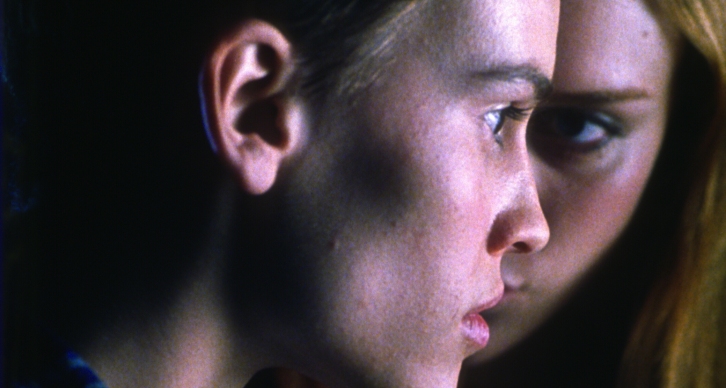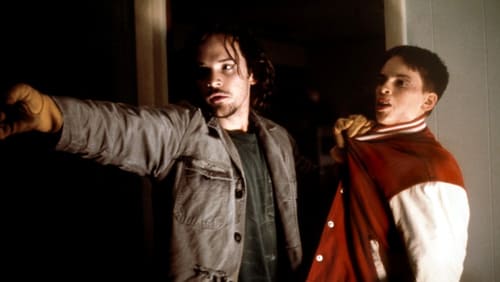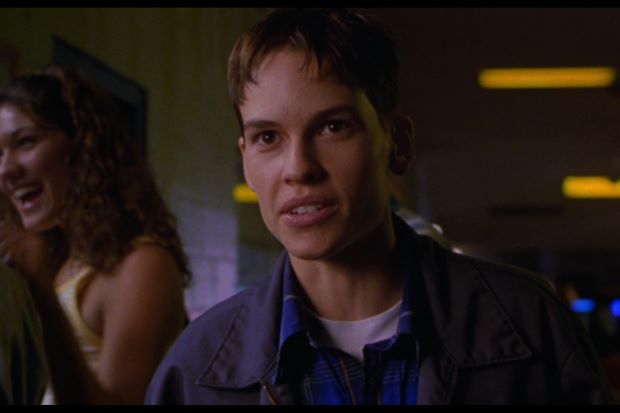Kimberly Peirce: I AM Boys Don't Cry
Boys Don’t Cry (1999) feat. Hilary Swank as Brandon Teena, Peter Sarsgaard as John Lotter, and Brendon Sexton III as Tom Nissen - Courtesy of Fox Searchlight
Written by Editor-In-Chief, Liberté Grace
The Academy Award-winning film Boys Don’t Cry, directed by Kimberly Peirce—then a first-time writer and director—was a groundbreaking independent feature made for just two million dollars. It went on to become an unlikely favourite at the 72nd Academy Awards, catapulting the careers of Hilary Swank and Chloë Sevigny.
In 2000, Peirce, a graduate of both the Sundance Lab and Columbia University’s film programme, watched as her lead actor, Hilary Swank, won the Oscar for Best Actress for her critically acclaimed portrayal of Brandon Teena—a transgender youth who, in rural Nebraska, dared to live and love as a boy. Tragically, Brandon was raped and murdered after his birth identity as a girl was revealed.
Boys Don’t Cry (1999) highlights - Courtesy of Fox Searchlight
On the 20th anniversary of her breakout directorial debut, Kimberly Peirce gave I AM FILM a candid interview in which she reflected on how Boys Don’t Cry became the indie phenomenon that transformed the landscape of independent filmmaking. She also shared her thoughts on being a female director in Hollywood today, speaking at the WUTI Goes IdyllWild Film Festival, where the film was celebrated with a special anniversary screening.
Boys Don’t Cry helped pave the way for independent filmmakers to dream of winning an Oscar, democratizing a playing field that, at the time, was largely reserved for mainstream, high-budget films. More significantly, it brought visibility and dignity to transgender and gender-diverse communities across the world.
Peirce recalls that she "literally couldn’t believe it" when Hilary Swank stood on the Oscars stage, telling the world that she had once lived in a trailer park, as she accepted her Best Actress award in a category that included acting royalty such as Meryl Streep, Annette Bening and Julianne Moore. From that moment on, A-list actors became more willing to take on smaller, independent films with riskier and more diverse narratives.
Hilary Swank wins the Best Actress Oscar at the 72nd Academy Awards - Courtesy of Oscars.go.com
When I ask Peirce how a film about a transgender youth came to capture the zeitgeist in a predominantly heteronormative world, she seems to take pleasure in the fact that, as a film school graduate, she never set out to do so. Instead, before discovering Brandon’s story, she had been noticing that the world around her, and her education, lacked a language to articulate her emerging sense of female masculinity.
With no adequate means to express who she was, Peirce poignantly describes how Boys Don’t Cry grew out of her own personal need to carve out a place and a voice in the world. “I just knew that who I was, and the deep interest I had in storytelling, were going beyond the boundaries of what I was having access to in my Upper West Side New York community.”
At the time, Peirce was a film student writing a script about a woman who lived as a man during the American Civil War. As she began to realise her own gender-queer identity, she sought a way to capture her truth on film. She explains, “I was moving into my own and having to break ground in order to be the person I wanted to be, yet not surrender who I already was.”
“So my question was, ‘How do I tell the story of somebody who wants to live as a boy because it’s who they are? That was who I was.’”
Little did Peirce know that, just two months later, her question would be answered in the form of an article in The Village Voice, given to her by a friend. She recalls, “He said to me, ‘This is the story you want to tell.’ It was the middle of the night, and I read about this person, Brandon Teena, born Teena Brandon—someone who was female-bodied but lived as a boy. Brandon was everything I was aspiring to be.”
Peirce, who credits the movie gods for that life-changing moment in 1994, changed her thesis project, and over the next five years, she committed herself to bringing Brandon Teena’s story to the screen. She enthuses, “I think the amazing thing about the film was that I had no roadmap at all. In my institutional setting, they couldn’t grasp what I was doing.”
In her quest to define her protagonist’s internal conflict, she turned to legendary screenwriter Frank Pierson, who wrote Dog Day Afternoon and Cool Hand Luke, and who had been a mentor to her at the Sundance Lab. “I said, ‘Frank, I’ve got a problem. My teachers say that Brandon has to either want to be a boy or want to make love to women, and I have to choose.’
And he's like, “Brandon’s need is what Sonny’s need is in Dog Day Afternoon—to be loved.” Frank was a straight, white man, so it was remarkable that he didn’t need to consider the specifics of being transgender or queer. "If you want to understand why it hit a cultural zeitgeist and why it was so powerful," Peirce reflects, "it’s because I managed to find the universal in a very specific story.”
Ultimately, it was Peirce’s own desire to express who she authentically was—something that mirrored her protagonist’s journey—that became the thread connecting their two worlds. This connection played a pivotal role in the film’s historic success and in humanising the transgender experience for a global mainstream audience.
“That’s the beauty of great storytelling. For me, it was creating a compassion piece in the world of the way that I lived and loved because that didn’t exist. For people who were queer, it was so powerful because it gave us that. For people who were not queer, it had its humanity. So it transcended.”
When I ask how her career changed at that time, Peirce replies, “For any young, independent filmmaker, making that first feature is a big deal. To make a feature that makes money is important. But to make a feature that’s well-made, critically acclaimed, and wins an Oscar—that hadn’t really been done in that way because independent films didn’t win Oscars back then.”
Peirce recalls the pivotal moment when she was on the Oscars red carpet, being interviewed by Joan Rivers. “Joan said, ‘So, tell me about your movie.’ And I said, ‘I made a film about Brandon Teena, who lives as a man, loves women, and was killed for how he lived and loved.’ That ended up on the chyron over the entire red carpet.”
“My queer friends from New York called me on the red carpet, and I picked up— which you’re not supposed to do. They were like, ‘Dude! You’re talking to Joan Rivers, and you just said butch, lesbian, and transsexual—and 80 million people just heard you!’”
Kimberly Peirce on the Oscars red carpet - Photo by Kevin Winter/Getty Images Entertainment / Getty Images
They were crying because it was such a significant moment in terms of corrective history—making this story accessible, lovable, and normalising it. Not in a generic sense, but by providing the right language to a mainstream audience.
For me, not only was I now seen as a skilled filmmaker, but I was also meeting executives and producers. Francis Ford Coppola and Scorsese approached me and wanted to meet. That meant a lot because I’d been studying their work for so long, and now, to be in a conversation with people who loved movies as much as I did—it was amazing.”
Today, Peirce is a governor at The Academy, alongside Steven Spielberg and Susanne Bier, helping to bring in new members to foster diversity. She also serves as a board member of the Directors Guild of America. Aware firsthand of the systemic obstacles women face both behind and in front of the camera, she was one of the first voices to call for Harvey Weinstein’s expulsion from the Academy’s membership.
BTS Carrie (2013) feat. Kimberly Peirce and Chloë Grace Moretz - Photo by Michael Gibson | © 2012 Metro-Goldwyn-Mayer Pictures Inc. and Screen Gems, Inc., - Courtesy of Sony Pictures
When I ask her about the reality behind the scenes for female directors in Hollywood, she’s blunt: “When I look back, what ended up happening is that women don’t get the same resources that men do. Yes, you’ll be offered a lot of projects. But, as you enter Hollywood, to make a great movie, you generally need that great writer or re-writer."
She continues, “If you look at the top women who made it, you might ask, ‘Why were they so successful, and then, somehow, they stopped working?’ A) They’d already proven they could make money. B) They’d proven they were talented. They were certainly committed. It wasn’t a hobby. What happened was that these women were being undermined from within.”
Peirce adds, “Sure, you can get in the room. But openly, there’s a lot of undermining of your creative control. What these women were finding was that their ability to shape the story was being interfered with. You weren’t getting the right writer, or you were getting notes that didn’t make sense.”
“The boys were considered geniuses, so therefore, they would let them do what they needed to do. But they would interfere and destroy the women’s work over, and over, and over. And it’s partly because the industry has been formed around a male construction of narrative.”
According to Martha Lauzen, the executive director of the Center for the Study of Women in Television and Film, research shows that women accounted for only eight percent of directors working on the top 250 grossing films of 2018, and just four percent of those in the top 100. Over the past 20 years, there has been no meaningful increase in the percentage of women being hired as film directors.
I ask Peirce if there is a sense of threat from the older guard, now that women and minority groups are being invited to the table. She agrees: “Definitely. Being in the rooms, on the boards of different important institutions that shape cultural change, like The Academy, I can definitely say that, in those rooms, there didn’t used to be women or people of colour, but now there are. It has changed the conversation.”
She continues, “There are a number of men who are great, but there are some who feel threatened because a system of privilege is being eroded. If you were getting 95% of the jobs as a person from a certain group, and now you’re going to get 87%, there’s going to be less available to you.”
Boys Don’t Cry (1999) feat. Hilary Swank as Brandon Teena and Chloë Sevigny as Lana Tisdel - Courtesy of Fox Searchlight
What fascinates Peirce more, however, is the fear surrounding depictions of female desire on-screen. Boys Don’t Cry initially received an X rating and required an R rating in order to be widely distributed. Determined to protect the film’s authenticity, Peirce argued against the MPAA's demands to remove a shot of Brandon wiping semen off his face, shorten Lana’s orgasm, and cut the anal rape scene in order to secure an R rating.
Peirce describes how, “It was the worst thing they could have said to me, because I wanted those moments to be the most powerful. They told me, ‘It’s too potent.’ I said, ‘We never get to see women experience orgasm. We see men ejaculate everywhere in movies, and we have to watch it. That’s fine, everybody has a right to that. But let’s see women come. Who has ever been hurt by an orgasm that lasted too long?’”
“So, yes, I do believe that female desire, is something that we haven’t seen on-screen. And I think it makes people who are not focused on female desire, maybe uncomfortable. Maybe it makes some people realise how potent female desire is. And that’s scary.”
While Peirce acknowledges that the making of Boys Don’t Cry was more challenging due to the heterosexual-masculine culture of the industry and her own queer identity, she doesn’t believe in allowing internal politics to hold her or anyone else back. She offers this sage advice to filmmakers seeking a directing career:
“I follow what I have to do. It wasn’t really a choice with Brandon. If you embrace and follow what you truly love and need to do, you’ll find unimagined resources that empower you and enable you to achieve it. If it’s taken hold of me, then I should follow that, because it means it will take hold of others too.
So, I would just say—stop at nothing. Don’t hurt anyone. And any chance you get, always do that interview. Always get up early. Always go meet that actor. Always do that revision. If someone gives you a note, don’t get defensive—that’s time out of their life. Generally, I’ve found that I’ve learned so much from almost every note I’ve ever received. And I’ve gotten thousands. When I teach, I tell my students, ‘You’ve got to be on it.’”
You can learn more from Kimberly Peirce about filmmaking on Sundance Collab and follow Women Under The Influence, a community celebrating groundbreaking cinema, directed by women, for everyone, on Instagram @wutigoesidyllwild and @womenundertheinfluence.
For more news and interviews with the Masters Of Film, follow I AM FILM on Instagram @iamfilmofficial #IAMFILM #MastersOfFilm.
About the filmmaker
Kimberly Peirce
Writer, Director
Kimberly Peirce was born on September 8, 1967 in Harrisburg, Pennsylvania, USA. She is a director and writer, known for Boys Don't Cry (1999), Stop-Loss (2008) and Carrie (2013). She has directed two actors in Oscar-nominated performances: Hilary Swank and Chloë Sevigny. Swank won the Best Actress Award for Boys Don't Cry (1999). Her next feature film project, This is Jane, stars Michelle Williams. [Source: IMDb]











